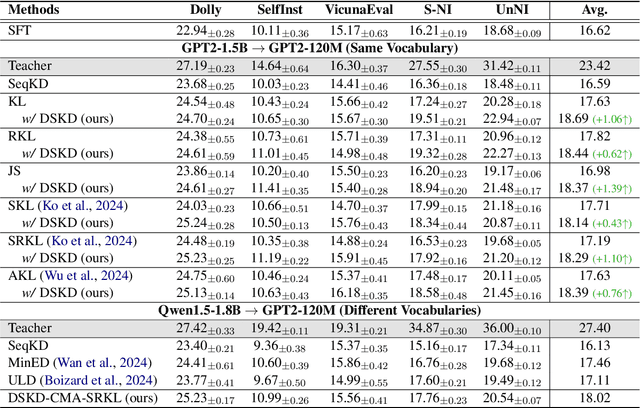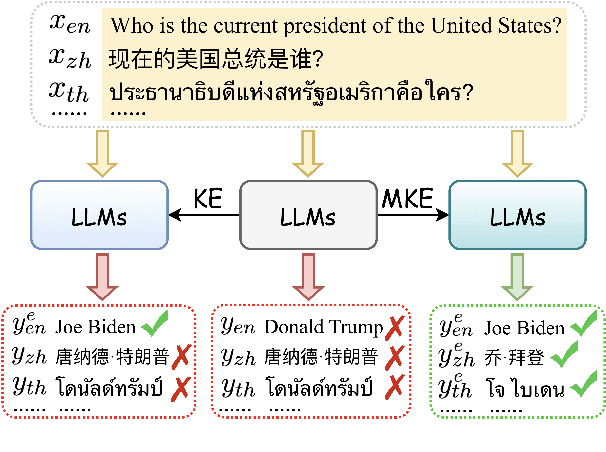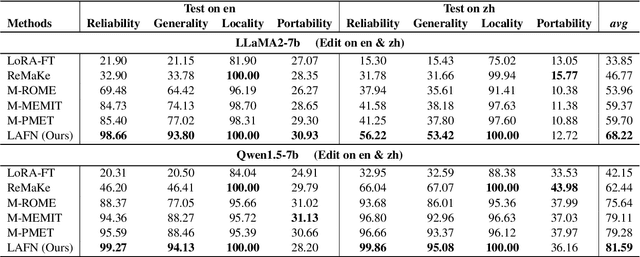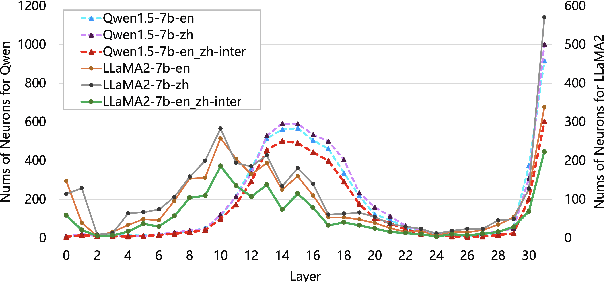Songming Zhang
A Dual-Space Framework for General Knowledge Distillation of Large Language Models
Apr 15, 2025Abstract:Knowledge distillation (KD) is a promising solution to compress large language models (LLMs) by transferring their knowledge to smaller models. During this process, white-box KD methods usually minimize the distance between the output distributions of the teacher model and the student model to transfer more information. However, we reveal that the current white-box KD framework exhibits two limitations: a) bridging probability distributions from different output spaces will limit the similarity between the teacher model and the student model; b) this framework cannot be applied to LLMs with different vocabularies. One of the root causes for these limitations is that the distributions from the teacher and the student for KD are output by different prediction heads, which yield distributions in different output spaces and dimensions. Therefore, in this paper, we propose a dual-space knowledge distillation (DSKD) framework that unifies the prediction heads of the teacher and the student models for KD. Specifically, we first introduce two projectors with ideal initialization to project the teacher/student hidden states into the student/teacher representation spaces. After this, the hidden states from different models can share the same head and unify the output spaces of the distributions. Furthermore, we develop an exact token alignment (ETA) algorithm to align the same tokens in two differently-tokenized sequences. Based on the above, our DSKD framework is a general KD framework that supports both off-policy and on-policy KD, and KD between any two LLMs regardless of their vocabularies. Extensive experiments on instruction-following, mathematical reasoning, and code generation benchmarks show that DSKD significantly outperforms existing methods based on the current white-box KD framework and surpasses other cross-tokenizer KD methods for LLMs with different vocabularies.
AlignDistil: Token-Level Language Model Alignment as Adaptive Policy Distillation
Mar 04, 2025Abstract:In modern large language models (LLMs), LLM alignment is of crucial importance and is typically achieved through methods such as reinforcement learning from human feedback (RLHF) and direct preference optimization (DPO). However, in most existing methods for LLM alignment, all tokens in the response are optimized using a sparse, response-level reward or preference annotation. The ignorance of token-level rewards may erroneously punish high-quality tokens or encourage low-quality tokens, resulting in suboptimal performance and slow convergence speed. To address this issue, we propose AlignDistil, an RLHF-equivalent distillation method for token-level reward optimization. Specifically, we introduce the reward learned by DPO into the RLHF objective and theoretically prove the equivalence between this objective and a token-level distillation process, where the teacher distribution linearly combines the logits from the DPO model and a reference model. On this basis, we further bridge the accuracy gap between the reward from the DPO model and the pure reward model, by building a contrastive DPO reward with a normal and a reverse DPO model. Moreover, to avoid under- and over-optimization on different tokens, we design a token adaptive logit extrapolation mechanism to construct an appropriate teacher distribution for each token. Experimental results demonstrate the superiority of our AlignDistil over existing methods and showcase fast convergence due to its token-level distributional reward optimization.
Dual-Space Knowledge Distillation for Large Language Models
Jun 25, 2024



Abstract:Knowledge distillation (KD) is known as a promising solution to compress large language models (LLMs) via transferring their knowledge to smaller models. During this process, white-box KD methods usually minimize the distance between the output distributions of the two models so that more knowledge can be transferred. However, in the current white-box KD framework, the output distributions are from the respective output spaces of the two models, using their own prediction heads. We argue that the space discrepancy will lead to low similarity between the teacher model and the student model on both representation and distribution levels. Furthermore, this discrepancy also hinders the KD process between models with different vocabularies, which is common for current LLMs. To address these issues, we propose a dual-space knowledge distillation (DSKD) framework that unifies the output spaces of the two models for KD. On the basis of DSKD, we further develop a cross-model attention mechanism, which can automatically align the representations of the two models with different vocabularies. Thus, our framework is not only compatible with various distance functions for KD (e.g., KL divergence) like the current framework, but also supports KD between any two LLMs regardless of their vocabularies. Experiments on task-agnostic instruction-following benchmarks show that DSKD significantly outperforms the current white-box KD framework with various distance functions, and also surpasses existing KD methods for LLMs with different vocabularies.
Multilingual Knowledge Editing with Language-Agnostic Factual Neurons
Jun 24, 2024



Abstract:Multilingual knowledge editing (MKE) aims to simultaneously revise factual knowledge across multilingual languages within large language models (LLMs). However, most existing MKE methods just adapt existing monolingual editing methods to multilingual scenarios, overlooking the deep semantic connections of the same factual knowledge between different languages, thereby limiting edit performance. To address this issue, we first investigate how LLMs represent multilingual factual knowledge and discover that the same factual knowledge in different languages generally activates a shared set of neurons, which we call language-agnostic factual neurons. These neurons represent the semantic connections between multilingual knowledge and are mainly located in certain layers. Inspired by this finding, we propose a new MKE method by locating and modifying Language-Agnostic Factual Neurons (LAFN) to simultaneously edit multilingual knowledge. Specifically, we first generate a set of paraphrases for each multilingual knowledge to be edited to precisely locate the corresponding language-agnostic factual neurons. Then we optimize the update values for modifying these located neurons to achieve simultaneous modification of the same factual knowledge in multiple languages. Experimental results on Bi-ZsRE and MzsRE benchmarks demonstrate that our method outperforms existing MKE methods and achieves remarkable edit performance, indicating the importance of considering the semantic connections among multilingual knowledge.
Revisiting Knowledge Distillation under Distribution Shift
Jan 07, 2024Abstract:Knowledge distillation transfers knowledge from large models into small models, and has recently made remarkable achievements. However, few studies has investigated the mechanism of knowledge distillation against distribution shift. Distribution shift refers to the data distribution drifts between training and testing phases. In this paper, we reconsider the paradigm of knowledge distillation by reformulating the objective function in shift situations. Under the real scenarios, we propose a unified and systematic framework to benchmark knowledge distillation against two general distributional shifts including diversity and correlation shift. The evaluation benchmark covers more than 30 methods from algorithmic, data-driven, and optimization perspectives for five benchmark datasets. Overall, we conduct extensive experiments on the student model. We reveal intriguing observations of poor teaching performance under distribution shifts; in particular, complex algorithms and data augmentation offer limited gains in many cases.
Are All Unseen Data Out-of-Distribution?
Jan 02, 2024



Abstract:Distributions of unseen data have been all treated as out-of-distribution (OOD), making their generalization a significant challenge. Much evidence suggests that the size increase of training data can monotonically decrease generalization errors in test data. However, this is not true from other observations and analysis. In particular, when the training data have multiple source domains and the test data contain distribution drifts, then not all generalization errors on the test data decrease monotonically with the increasing size of training data. Such a non-decreasing phenomenon is formally investigated under a linear setting with empirical verification across varying visual benchmarks. Motivated by these results, we redefine the OOD data as a type of data outside the convex hull of the training domains and prove a new generalization bound based on this new definition. It implies that the effectiveness of a well-trained model can be guaranteed for the unseen data that is within the convex hull of the training domains. But, for some data beyond the convex hull, a non-decreasing error trend can happen. Therefore, we investigate the performance of popular strategies such as data augmentation and pre-training to overcome this issue. Moreover, we propose a novel reinforcement learning selection algorithm in the source domains only that can deliver superior performance over the baseline methods.
A Quality-based Syntactic Template Retriever for Syntactically-controlled Paraphrase Generation
Oct 20, 2023



Abstract:Existing syntactically-controlled paraphrase generation (SPG) models perform promisingly with human-annotated or well-chosen syntactic templates. However, the difficulty of obtaining such templates actually hinders the practical application of SPG models. For one thing, the prohibitive cost makes it unfeasible to manually design decent templates for every source sentence. For another, the templates automatically retrieved by current heuristic methods are usually unreliable for SPG models to generate qualified paraphrases. To escape this dilemma, we propose a novel Quality-based Syntactic Template Retriever (QSTR) to retrieve templates based on the quality of the to-be-generated paraphrases. Furthermore, for situations requiring multiple paraphrases for each source sentence, we design a Diverse Templates Search (DTS) algorithm, which can enhance the diversity between paraphrases without sacrificing quality. Experiments demonstrate that QSTR can significantly surpass existing retrieval methods in generating high-quality paraphrases and even perform comparably with human-annotated templates in terms of reference-free metrics. Additionally, human evaluation and the performance on downstream tasks using our generated paraphrases for data augmentation showcase the potential of our QSTR and DTS algorithm in practical scenarios.
Towards Understanding and Improving Knowledge Distillation for Neural Machine Translation
May 14, 2023Abstract:Knowledge distillation (KD) is a promising technique for model compression in neural machine translation. However, where the knowledge hides in KD is still not clear, which may hinder the development of KD. In this work, we first unravel this mystery from an empirical perspective and show that the knowledge comes from the top-1 predictions of teachers, which also helps us build a potential connection between word- and sequence-level KD. Further, we point out two inherent issues in vanilla word-level KD based on this finding. Firstly, the current objective of KD spreads its focus to whole distributions to learn the knowledge, yet lacks special treatment on the most crucial top-1 information. Secondly, the knowledge is largely covered by the golden information due to the fact that most top-1 predictions of teachers overlap with ground-truth tokens, which further restricts the potential of KD. To address these issues, we propose a novel method named \textbf{T}op-1 \textbf{I}nformation \textbf{E}nhanced \textbf{K}nowledge \textbf{D}istillation (TIE-KD). Specifically, we design a hierarchical ranking loss to enforce the learning of the top-1 information from the teacher. Additionally, we develop an iterative KD procedure to infuse more additional knowledge by distilling on the data without ground-truth targets. Experiments on WMT'14 English-German, WMT'14 English-French and WMT'16 English-Romanian demonstrate that our method can respectively boost Transformer$_{base}$ students by +1.04, +0.60 and +1.11 BLEU scores and significantly outperform the vanilla word-level KD baseline. Besides, our method shows higher generalizability on different teacher-student capacity gaps than existing KD techniques.
Improved Data Augmentation for Translation Suggestion
Oct 12, 2022



Abstract:Translation suggestion (TS) models are used to automatically provide alternative suggestions for incorrect spans in sentences generated by machine translation. This paper introduces the system used in our submission to the WMT'22 Translation Suggestion shared task. Our system is based on the ensemble of different translation architectures, including Transformer, SA-Transformer, and DynamicConv. We use three strategies to construct synthetic data from parallel corpora to compensate for the lack of supervised data. In addition, we introduce a multi-phase pre-training strategy, adding an additional pre-training phase with in-domain data. We rank second and third on the English-German and English-Chinese bidirectional tasks, respectively.
Conditional Bilingual Mutual Information Based Adaptive Training for Neural Machine Translation
Mar 06, 2022



Abstract:Token-level adaptive training approaches can alleviate the token imbalance problem and thus improve neural machine translation, through re-weighting the losses of different target tokens based on specific statistical metrics (e.g., token frequency or mutual information). Given that standard translation models make predictions on the condition of previous target contexts, we argue that the above statistical metrics ignore target context information and may assign inappropriate weights to target tokens. While one possible solution is to directly take target contexts into these statistical metrics, the target-context-aware statistical computing is extremely expensive, and the corresponding storage overhead is unrealistic. To solve the above issues, we propose a target-context-aware metric, named conditional bilingual mutual information (CBMI), which makes it feasible to supplement target context information for statistical metrics. Particularly, our CBMI can be formalized as the log quotient of the translation model probability and language model probability by decomposing the conditional joint distribution. Thus CBMI can be efficiently calculated during model training without any pre-specific statistical calculations and large storage overhead. Furthermore, we propose an effective adaptive training approach based on both the token- and sentence-level CBMI. Experimental results on WMT14 English-German and WMT19 Chinese-English tasks show our approach can significantly outperform the Transformer baseline and other related methods.
 Add to Chrome
Add to Chrome Add to Firefox
Add to Firefox Add to Edge
Add to Edge